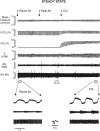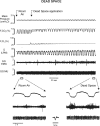Tonically discharging genioglossus motor units show no evidence of rate coding with hypercapnia
- PMID: 20053847
- PMCID: PMC2887629
- DOI: 10.1152/jn.00686.2009
Tonically discharging genioglossus motor units show no evidence of rate coding with hypercapnia
Abstract
The genioglossus (GG) is considered the principle protrudor muscle of the human tongue. Unlike most skeletal muscles, GG electromyographic (EMG) activities are robustly preserved in sleep and thus may fulfill a critical role in preserving airway patency. Previous studies in human subjects also confirm that the GG EMG increases in response to chemoreceptor and mechanoreceptor stimulation. This increase occurs secondary to the recruitment of previously inactive motor units (MUs) and/or an increase in firing rate of already active MUs. Which strategy the nervous system uses when the synaptic drive onto GG motoneurons increases is not known. Here we report on GG whole muscle and tonic MU activities under conditions that mimic sleep, i.e., mild-moderate elevations in CO(2) (3% inspired CO(2) or the addition of a 1.0 l dead space) and elevated airway resistance. Based on previous work in rat, we hypothesized that mild hypercapnia would increase the firing rates of tonic MUs and that these effects would be further potentiated by a modest increase in airway resistance. Fine wire and tungsten microelectrodes were inserted into the GG to record whole muscle and single MU activities in 21 subjects (13 women, 8 men; 20-55 yr). Either 3% inspired CO(2) or added dead space resulted in a 200-300% increase in the amplitude of both tonic and phasic components of the whole muscle GG EMG and a doubling of minute ventilation. Despite these changes, recordings obtained from a total of 84 tonically discharging GG single MUs provide no evidence of a change in firing rate under any of the conditions. On this basis we conclude that in healthy adults, the increase in the tonic component of the whole muscle GG EMG secondary to mild hypercapnia is due almost exclusively to the recruitment of previously inactive MUs.
Figures






Similar articles
-
Activities of human genioglossus motor units.Respir Physiol Neurobiol. 2011 Oct 15;179(1):14-22. doi: 10.1016/j.resp.2011.04.018. Epub 2011 Apr 22. Respir Physiol Neurobiol. 2011. PMID: 21558022 Free PMC article. Review.
-
Sleep/wake firing patterns of human genioglossus motor units.J Neurophysiol. 2007 Dec;98(6):3284-91. doi: 10.1152/jn.00865.2007. Epub 2007 Oct 10. J Neurophysiol. 2007. PMID: 17928550
-
Motor unit recruitment in human genioglossus muscle in response to hypercapnia.Sleep. 2010 Nov;33(11):1529-38. Sleep. 2010. PMID: 21102995 Free PMC article.
-
Tonic and phasic respiratory drives to human genioglossus motoneurons during breathing.J Neurophysiol. 2006 Apr;95(4):2213-21. doi: 10.1152/jn.00940.2005. Epub 2005 Nov 23. J Neurophysiol. 2006. PMID: 16306175
-
Discharge properties of upper airway motor units during wakefulness and sleep.Prog Brain Res. 2014;212:59-75. doi: 10.1016/B978-0-444-63488-7.00004-5. Prog Brain Res. 2014. PMID: 25194193 Review.
Cited by
-
Common synaptic input to the human hypoglossal motor nucleus.J Neurophysiol. 2011 Jan;105(1):380-7. doi: 10.1152/jn.00766.2010. Epub 2010 Nov 17. J Neurophysiol. 2011. PMID: 21084684 Free PMC article.
-
A mechanism for upper airway stability during slow wave sleep.Sleep. 2013 Apr 1;36(4):555-63. doi: 10.5665/sleep.2544. Sleep. 2013. PMID: 23565001 Free PMC article.
-
Physiological mechanisms of upper airway hypotonia during REM sleep.Sleep. 2014 Mar 1;37(3):561-9. doi: 10.5665/sleep.3498. Sleep. 2014. PMID: 24587579 Free PMC article.
-
Activities of human genioglossus motor units.Respir Physiol Neurobiol. 2011 Oct 15;179(1):14-22. doi: 10.1016/j.resp.2011.04.018. Epub 2011 Apr 22. Respir Physiol Neurobiol. 2011. PMID: 21558022 Free PMC article. Review.
-
A comprehensive assessment of genioglossus electromyographic activity in healthy adults.J Neurophysiol. 2015 Apr 1;113(7):2692-9. doi: 10.1152/jn.00975.2014. Epub 2015 Feb 18. J Neurophysiol. 2015. PMID: 25695653 Free PMC article.
References
-
- Alex CG, Aronson RM, Onal E, Lopata M. Effects of continuous positive airway pressure on upper airway and respiratory muscle activity. J Appl Physiol 62: 2026–2030, 1987 - PubMed
-
- Bailey EF, Fridel KW, Rice AD. Sleep/wake firing patterns of human genioglossus motor units. J Neurophysiol 98: 3284–3291, 2007a - PubMed
Publication types
MeSH terms
Substances
Grants and funding
LinkOut - more resources
Full Text Sources
Research Materials

